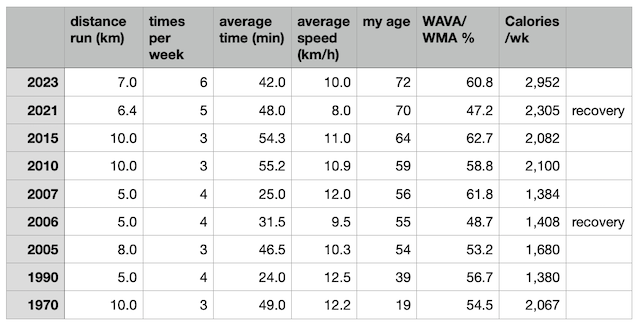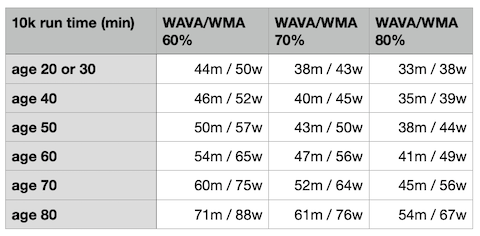
I confess: I hate exercising. I’ve been doing it, on and off, for more than 50 years. Partly this is out of vanity, since I do look better for doing it. And partly it is because I just feel better — healthier, less creaky, more resilient — when I do it. But whether it’s outside or in the gym, the guy dragging himself out of my apartment to exercise is not a happy person.
I am also something of a statistics nut, and I’ve been tracking my running times (and walking times, when I wasn’t up for running) over various distances since I was a teenager. That has helped greatly in figuring out the role of exercise in recovering from various ailments over the past five decades.
And fortunately, there are other statistics geeks among runners as well. One of the most valuable statistics I’ve been tracking is something called WAVA (now renamed WMA). What it represents is your average speed for a particular distance as a percentage of the speed of the top performers in the world of your age, over the same distance. One number tells the whole story.
Generally speaking, if you have a WAVA/WMA score of 60%, you’re going to put in a good showing in a fun run — probably in the top 20% or so of your age cohort. If your WAVA/WMA score is 70%, you could probably perform credibly in regional events, and if it’s 80%, you might qualify for national events of your age cohort. There’s a calculator if you want to compute your own score.
Here’s a chart showing for men (m) and women (w) what your time in minutes for a 10k run would have to be to meet the 60%, 70% and 80% thresholds. (World record time is 26:11 for men and 29:01 for women, both held by African runners, unchanged after this week’s world athletic championships; for runners over age 50, world record is 30:04 for men and 34:14 for women.):

I am not metabolically a distance runner. I was one of the fastest sprinters in the 100m and 200m in my high school, and my WAVA/WMA % at those distances was (and probably still is) in the 80-90% range. By the time I get up to a 5k run, however, I have to work to keep my WAVA/WMA % score at 60% or higher. But as the table at the top of this post shows, I seem to have been able to keep achieving that score with sufficient exercise. In 2006, when I was levelled by colitis, and in 2021, when I came up lame with repeated leg sprains (for reasons still unknown), I did have to face a slow rehab to get my score back over 60%. And it’s been there for the past six months, with nary an ailment.
There is of course another important number in fitness, and that’s the number of calories you burn. Common wisdom is that men on average burn 2,000 calories/day and women 1,500 calories/day without exercise, and that good health requires burning an additional 500 calories/day (2,000-3,000 calories/week) through strenuous exercise.
Unfortunately, the numbers just don’t add up to support this contention. One calorie of consumed food does not equate to one calorie of energy burned through exercise or other activities. The general rules of thumb ignore the complexities of how different types and paces of exercise contribute to fitness, and about what form the calories we consume are in, and even about what time of day we eat and exercise.
Nevertheless, the WAVA/WMA % only describes the intensity of exercise you’ve achieved, and calories, alas, seem to be the only measure that also considers the duration of the exercise. If you want a rule of thumb for computing calories burned (sorry, Americans, this only works in the metric system) here it is:
your average speed (km/h) x number of minutes exercised x weight in kg /55
So for a 72kg runner, 40 minutes at 10 km/h (fast jog) burns 530 calories. There’s your 500 excess calories per day, if that’s your intention. Equivalents would be 50 minutes at 8 km/h or 60 minutes at 6.5 km/h (slow jog). If you don’t like math or can’t manage metric, here’s a calculator for calories burned.
No matter how you calculate it, 500 excess calories per day, at least five days a week, is a lot more exercise than most people get in a normal week. And the above calculation is only for jogging and running. If you want to burn your 500+ excess calories a day walking at an intermediate 5.5 km/h speed, you’ll have to walk for two hours a day to do it. As the chart at the top of this post shows, there have been times in my life when I’ve gotten this target amount of exercise, and other times when I’ve fallen short.
Oh, and one more thing: You may have learned the rule for a safe maximum heart rate as 220 minus your age, in beats per minute (bpm). That rule is obsolete, especially for older people. The new rule is:
211 – (your age x .64) bpm
So for a 40 year old the new limit is 185 beats per minute, and for a 70 year old it’s 165. Of course, it depends a bit on your height and weight, so here’s a more precise calculator for your maximum heart rate (HRMax, which, the site explains, you should stay 8-10 bpm below). Sorry, it’s metric too. It also calculates your BMI, which can be handy to know.
My gym’s treadmills monitor heart rate, and I’ve found this calculator to be very helpful. When I was middle-aged, I used to slow down if my heart rate exceeded 185. At my current pace at age 72, even after 40 minutes at 10 km/h my heart rate rarely exceeds 155. Those just feel like the right maximums to keep to.
So, I guess the answer to the question post in this article’s title is:
- Yes, I am as fit now as I was in my 20s, and have been intermittently throughout my life.
- But when I worked out only 3 days a week, or relied on an hour a day’s walking for my exercise, my fitness level dropped considerably. It’s just not enough.
I won’t annoy you this time around with my thoughts on diet, which always get me into trouble when I write about them. Though I will say that I have been following something called the 16/8 intermittent fasting diet (eating only between noon and 8pm each day) for several months now and found it has (1) reduced my late night food cravings and (2) also unintentionally led to a significant but not unhealthy drop in my average weight to the exact midpoint (21) of the recommended BMI range. I have no idea why it seems to work for me.
I think that’s more than enough maths and statistics for today. I hope you found some of this stuff interesting.





Thanks Dave interesting. At 84 and still exercising I have had similar interests. Does “use it or lose it” dominate over “wear and tear”?. My scores are down to around 50% by your charts. Liebig’s law of the minimum may be at play. Some one factor becomes critical and limits physical performance. Specifically it may be cardiac. If I press the “running” times toward 60-70% I get something akin to atrial fibrillation on the consumer smart phone EKG. Does one continue to press the limit? Or relax and survive longer but less active? Hmmm.
Data gets a little thin at 84, there is survivorship bias. Peter Attia has a hundred year old olympics suggestion that allows multiple objectives. Walk a mile, get up from the floor etc. A decathlon for your 90-100 years.
I’m thinking of one of the early survival bloggers Joe…something, blogging from South America (it’s really bugging me that I can’t remember his name he died about a decade ago). Anyway, I recall you writing about visiting him, and coming back claiming you just weren’t fit enough to live outside civilization. Perhaps that way of life required a different kind of fitness? I wonder if that could be measured?
Thanks, bogwood. Yeah, I would never try pushing to a 185 heart rate at my age, which I did all the time in my 40s and 50s. It took me a whole year after the muscle pulls to slowly get back to running 7k without pushing past 155 bpm.
Theresa: You mean Joe Bageant, who blogged from Belize in Central America. Yes, interesting idea to come up with such a measure. Some of my regular readers who live off the grid and otherwise on the ‘edges’ of civilization might be better able to suggest what that would be. The word ‘resilience’ is overdone and misused, but I think it’s an important part of it. More specifically, the capacity to adapt to quickly changing circumstances without getting stressed about it, and the ability to ‘let go’ of painful experiences (really hard for most human ‘selves’ I think) without getting traumatized by them.
I am curious, if 8pm is the end of your eating, at what time were late night food cravings happening?!
I am sure you are familiar with this podcast. I remember listening to Dr Panda: https://dexa.ai/huberman/episodes/doc_2052 – the link to the interview is at the top.
Fascinating the connection between sleep, and everything else. I believe he eats meals, or tries to, between 8am and 6pm, from memory. Hence my comment that 8pm even seems late. But then another takeaway from another interview on sleep was that consistency in sleeping and waking times was extremely important to get the most benefits from sleep, from which so much follows.
I’m a night-owl, so I used to love, and indulge, my midnight snacks. Usually sleep 2am-10am, and now rarely feel at all hungry before noon or after 8pm. What the body gets used to, I guess.
I agree that “resilience” is a word that has been misused a lot lately. Was just reading about how some folks stranded at the Burning Man situation claim that they have seen a lot of “resilience” in the stranded attendees helping each other out. What they are responding to is the novelty of the so called disaster – something that tends to bring out the best in civilized people who’s main problems in life come down to boredom. I reckon the early stages of collapse (whether of civilization or an aging or sick human body) will energize people to be attentive to the needs of themselves and others. Not so sure theyy would have the resilience to deal with middle and end stages.